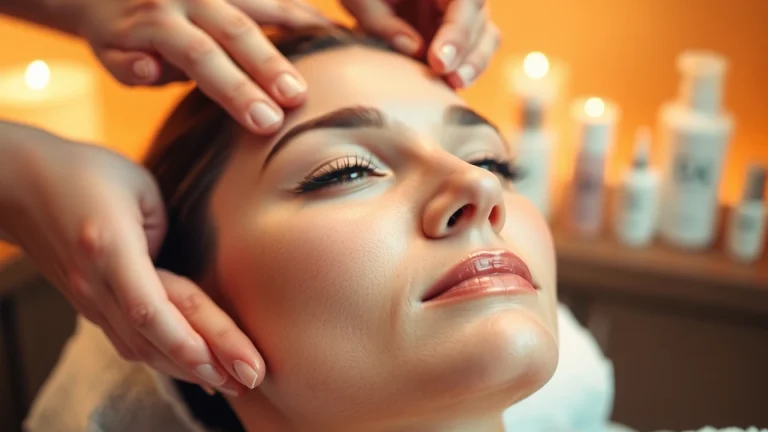
Reveal Your Glow: Essential Facial Tips for Radiant Skin Care
1. Understanding Facials: The Basics of Skin Rejuvenation
1.1 What is a Facial?
A facial is a multi-step skin treatment that typically includes cleansing, exfoliation, extraction of blackheads, masks, and moisturization. Its primary purpose is to rejuvenate the skin, promoting a clear, well-hydrated, and more youthful appearance. Facials are tailored to meet various skin needs, making them an essential part of skincare regimens for many individuals. Whether you’re seeking to manage acne, hydrate dry skin, or simply indulge in a relaxing self-care routine, a facial can be a beneficial option.
1.2 Types of Facials and Their Benefits
Facials come in numerous varieties, catering to different skin types and concerns. Below are some common types:
- Hydrating Facials: Designed to alleviate dry skin, these treatments incorporate hydrating ingredients such as hyaluronic acid and vitamin E to restore moisture levels.
- Deep Cleansing Facials: Ideal for oily or acne-prone skin, these facials focus on deeper exfoliation and extraction, removing impurities and minimizing breakouts.
- Anti-Aging Facials: These treatments often include retinols, antioxidants, and peptides to target signs of aging like fine lines and wrinkles.
- Brightening Facials: Utilizing ingredients like vitamin C, these facials aim to lighten hyperpigmentation and enhance the skin’s luminosity.
- Calming Facials: Perfect for sensitive skin, these facials include soothing components like chamomile or aloe vera to reduce redness and irritation.
1.3 Common Ingredients Used in Facial Treatments
Facial treatments employ a broad spectrum of ingredients tailored to specific skin goals. Some widely used ingredients include:
- Salicylic Acid: Effective for oily skin, this beta-hydroxy acid helps clear out pores.
- Glycolic Acid: An alpha-hydroxy acid, glycolic aids in exfoliation and is ideal for improving uneven texture.
- Retinol: Known for its anti-aging properties, retinol promotes cell turnover.
- Hyaluronic Acid: A humectant that attracts moisture and is essential for hydration.
- Antioxidants: Ingredients like vitamin C and green tea protect the skin from the effects of free radicals.
2. Choosing the Right Facial for Your Skin Type
2.1 Identifying Your Skin Type
To select the right facial, it’s crucial to first assess your skin type. The common categories include:
- Oily Skin: Characterized by excess sebum production, which can lead to enlarged pores and acne.
- Dry Skin: Often feels tight and may appear flaky or rough.
- Combination Skin: Displays traits from multiple skin types; typically, an oily T-zone with dry patches.
- Sensitive Skin: Prone to redness, irritation, and reactions from various products and environments.
- Normal Skin: Well-balanced, neither too oily nor too dry, with minimal issues.
2.2 Tailoring Facials to Different Skin Conditions
Once you’ve identified your skin type, you can more accurately choose facials that will be effective for your concerns. For instance:
- For Oily Skin: Look for deep cleansing or clarifying facials that involve salicylic acid.
- For Dry Skin: Emphasize hydrating facials rich in soothing ingredients like aloe vera or essential oils.
- For Acne-Prone Skin: Select facials focusing on exfoliation and extraction.
- For Sensitive Skin: Opt for calming facials that use gentle, natural ingredients.
- For Aging Skin: Choose anti-aging facials featuring retinol and peptides to promote firmness.
2.3 Professional vs. At-Home Facials
There are two primary options when it comes to facials: professional treatments and at-home applications. Professional facials offer personalized care with access to advanced technologies and potent products, often yielding quicker results. However, at-home facials provide convenience and can be tailored to your schedule. For an effective regimen, consider alternating between professional treatments and a meticulous at-home routine to maintain results.
3. Preparing for a Facial: Tips for Optimal Results
3.1 Pre-Facial Skincare Routine
To maximize the benefits of your facial, following a pre-facial skincare routine is essential. This may include:
- Gentle Cleansing: Ensure your skin is clean to facilitate the extraction process.
- Exfoliation: Lightly exfoliate the night before to slough off dead skin cells.
- Hydration: Moisturize adequately to avoid overly dry skin, but avoid heavy oils that could clog pores.
- Avoiding Irritants: Steer clear of harsh products like retinoids or acids for a few days leading up to your facial.
3.2 Scheduling and Timing for Best Outcomes
The timing of your facial can significantly impact its effectiveness. Experts recommend scheduling your facial based on your lifestyle. For instance, scheduling it on a Friday can allow for time to recover if sensitive to treatments, ensuring you enter the weekend glowingly. Additionally, consider your skin’s cycle — facials can be more beneficial during certain times, such as when experiencing hormonal acne.
3.3 What to Expect During Your Facial
Understanding what to expect can alleviate nerves for first-timers. Generally, a facial will follow this process:
- Consultation: Initial discussion regarding your skin concerns and desired results.
- Cleansing: Thoroughly cleaning your face to remove any makeup and impurities.
- Exfoliation: Using manual or chemical methods to remove dead skin cells.
- Extraction: Carefully removing blackheads or clogged pores, if necessary.
- Mask: Application of a tailored mask based on your skin needs.
- Moisturizing: Concluding with a moisturizer to lock in hydration.
4. Post-Facial Care: Maintaining Your Radiance
4.1 Best Practices for Post-Facial Skin Care
After your facial, adhering to specific care practices can ensure lasting results. Here are essential tips:
- Hydrate: Keep your skin hydrated with appropriate moisturizers.
- Sun Protection: Apply sunscreen diligently, especially if your facial included exfoliation or chemicals.
- Avoid Heat: Refrain from saunas or hot showers for at least 48 hours post-treatment.
- Do Not Pick: Avoid touching your face to prevent irritation or infection.
4.2 Products to Use After a Facial
Using the right products post-facial can enhance your results tremendously. Consider the following:
- Moisturizers: Look for lightweight, non-comedogenic options to stave off dryness.
- Serums: Use serums rich in antioxidants or hyaluronic acid for further hydration and protection.
- Sunscreens: Invest in broad-spectrum SPF to protect repaired skin from harmful UV rays.
4.3 Avoiding Common Post-Facial Mistakes
Many individuals unknowingly undermine their results by making common mistakes, such as:
- Using Harsh Products: Avoid retinols or exfoliants directly after your facial.
- Neglecting Sunscreen: Always wear sunscreen post-facial to protect your newly treated skin.
- Skipping Hydration: Hydration is key post-facial; prioritize moisturizing products.
5. Finding the Right Facial Provider: Tips for a Great Experience
5.1 How to Research Local Facial Services
Finding a reputable facial provider involves thorough research. Start by:
- Checking Credentials: Ensure they are licensed and certified.
- Reading Online Reviews: Look for feedback on various platforms to get a sense of the provider’s reputation.
- Examining Treatment Options: Make sure they offer the facials that cater to your specific skin needs.
5.2 Key Questions to Ask Your Facial Specialist
When consulting with a facial specialist, asking the right questions can lead to a more satisfying experience. Consider inquiring about:
- Professional Experience: How long have they been in practice?
- Treatment Plans: What specific treatments do they recommend based on your skin type?
- Safety Protocols: How do they ensure cleanliness and safety during treatments?
5.3 Reading Reviews and Gaining Recommendations
Utilizing reviews can give valuable insights. Seek recommendations from friends or family, or explore online communities centered on skincare. Websites dedicated to skincare often provide a space for personal experiences, leading you to find the right provider for your needs.


